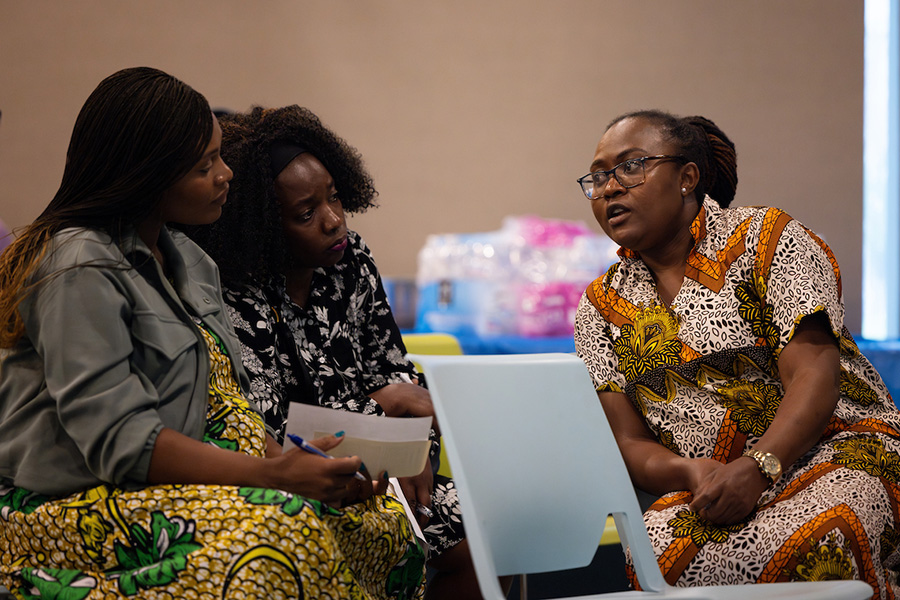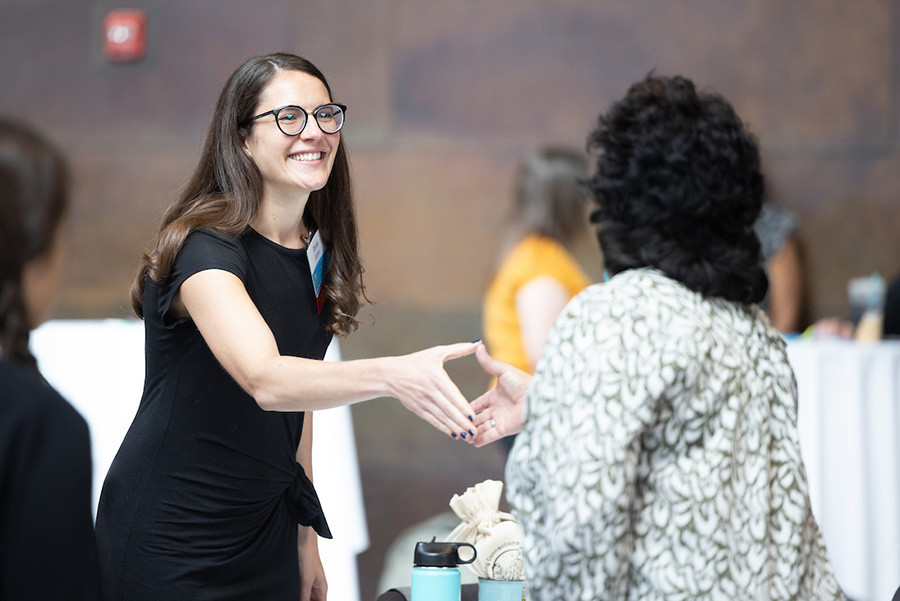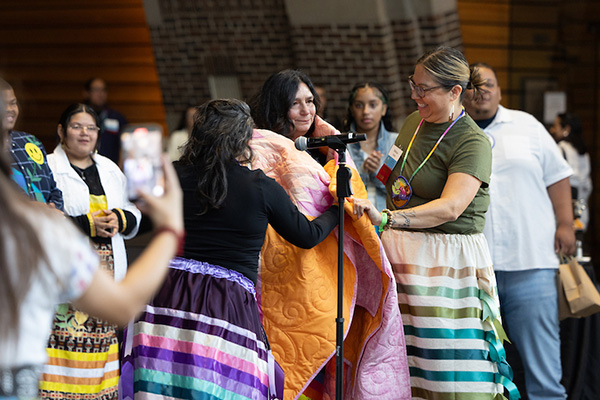
In the spring of 2021, when COVID-19 vaccines were finally widely available and millions of Americans were lining up at CVS and Walgreens pharmacies to get their dose, news outlets and public health officials trumpeted the impending “return to normal.” But not all communities immediately jumped on board, according to SPH researcher Inari Mohammed. “We were seeing lower vaccine uptake in communities of color,” said Mohammed. “I really wanted to get at why that was.” After surveying dozens of women from Minnesota’s Black community, Mohammed uncovered the root of the problem. In a nutshell? Blame the messenger.
“People wondered why there didn’t seem to be an attempt to have messages coming from people who looked like them,” Mohammed said. “People said they would have felt more comfortable with the vaccine and had greater trust in it if those urging its uptake were Black or came from other communities of color.”
At one level, these women were speaking to the lack of representation and inclusiveness that has often plagued public health messaging. For example, the people urging vaccination were overwhelmingly male and white. Also, most of the outreach to immigrant communities was in English, and even outreach campaigns that attempted translations often failed to grasp the language or dialect of the target audience.
But the problem wasn’t just the messenger. The responses from these women went beyond inclusivity to touch on issues of trust and, specifically, some of the country’s most painful and unresolved chapters. “People told us there had to be an attempt to address past public health traumas,” said Mohammed.
“People were like, ‘why all the attention now’? Our communities have been facing public health emergencies for decades, and instead of acknowledgement or help, it’s been silence,” said Mohammed. “Public health can’t just jump in and demand that people do something — in this case, get the COVID vaccine — when at all other times there hasn’t been an effort to communicate or help address problems that communities of color continue to face.”
That essential experience — being marginalized, having one’s unique experiences and traumas be overlooked, being expected to heed advice from people you don’t necessarily trust — lies at the heart of many of the challenges that have plagued the public health system for many years and have led to gross disparities in our nation’s health outcomes. In response to this, many public health researchers — including at the University of Minnesota School of Public Health — have adopted an approach to research that recognizes the unique life experiences of people in specific communities, and allows their needs to drive research.
Embracing a Culturally Tailored Approach
For generations, public health initiatives employed a generalized approach, rooted in the assumption that what works for one community would apply equally to all. However, this approach created a system that prioritized and advanced the concerns of the dominant culture while exacerbating public health disparities for others. In a world where white people — and mainly white men — occupied influential policy positions and drove the vast majority of the research funding decisions, the outcome of public health campaigns became sadly predictable.
So even as funding and public awareness of the importance of public health grew, the persistence of health inequities remained and, in many cases, deepened among Black, Indigenous, and People of Color (BIPOC), LGBTQIA+, and other historically marginalized communities. Today, cancer mortality rates for American Indian people are among the highest in the nation, the economic burden of health inequities falls harder on Black people than on any other group, and LGBTQIA+ people experience higher rates of cancer and other preventable diseases.
On top of all of this, festering scars — think the Tuskegee experiment where Black men were not treated for syphilis to study the disease, and the medical use of Henrietta Lacks’ cells for medical experimentation without her consent — continued to dampen trust among many communities.
In contrast, culturally-tailored public health campaigns are designed to resonate with specific groups of people by incorporating language, imagery, and messaging that reflects a community’s identities, values, and lived experiences. To be truly effective and drive actual behavior change and improve health outcomes, though, culturally- tailored public health campaigns must be built on trust, and open, honest relationships, says SPH Assistant Professor Ivan Wu.
Wu said that when he arrived in the Twin Cities almost two years ago, he didn’t have any meaningful knowledge of the local communities. “I started by reaching out and asking community leaders what work they’re doing, what they see as their community’s health priorities,” Wu recalls. “This work is all about human relationships, so I try to take off my researcher hat while keeping in mind the legacy of institutional mistrust and historical trauma within various communities, and try to approach people at a human level with the idea that we’re all really trying to solve similar problems. If our visions align and our energies align, good things can happen.”
Today, Wu has successfully forged connections in the Twin Cities’ East African community. Along with an East African community-based organization, he is engaged in an effort to address disparities in cancer rates by understanding what Somali and Oromo adults in the community know about cancer to promote cancer screening, healthy lifestyles, and reduce cancer-related stigma.
Leading Community-engaged Research
That approach — building trust and working with communities to address vexing public health challenges — has been at the heart of the School of Public Health’s research for decades.
Take SPH Assistant Professor Manka Nkimbeng, whose work focuses on immigrant communities, who, she says, often confront a range of health-related challenges as they adjust to life in a new country. “People arrive here from Africa or the Caribbean and so many things are different — their diet, their lifestyle, the social connections, the climate,” Nkimbeng says. “These factors can accumulate in a way that is detrimental to their health, and as public health researchers, we need to learn from people in the community and determine how we can adapt interventions to address these challenges.”
In order to better understand a key challenge in the Twin Cities African immigrant community — the lack of education around dementia for those who have the disease as well as their caretakers — Nkimbeng hosted community-based conversations about dementia and dementia care.
“Many people in the community did not have a clear idea of what dementia is and saw it as a stigma,” Nkimbeng says. “And because mental health or cognitive issues are not openly discussed or well understood, some members of the community viewed dementia from a spiritual perspective — as a curse or witchcraft. There was a big need for dementia education tailored to the specific needs of the community.”
“If our visions align and our energies align, good things can happen.”
Ivan Wu
Those conversations led directly to a new booklet about dementia for the African immigrant community. “We did a lot of work to adapt it to the cultural practices and values that would make sense to people in the community,” Nkimbeng says. “Even the pictures in the book are of older African immigrants! We wanted people to be able to see themselves and understand that dementia is a common health challenge.”
Addressing Past Traumas
For many historically marginalized communities, public health initiatives must acknowledge and address past traumas which, in the case of the LGBTQIA+ community, contribute to health disparities. Rajean Moone, the associate director for education in SPH’s Center for Healthy Aging & Innovation (CHAI), led a comprehensive survey of aging in LGBTQIA+ community that highlights a number of disparities, including a higher risk for developing cognitive impairment, a greater likelihood to smoke or drink excessively, and a greater likelihood to age alone.
Moone describes a conundrum known as the LGBTQIA+ Aging Paradox: “LGBTQIA+ people are less likely to have children or other family caregivers to assist them as they age. Also, if you’re an older LGBTQIA+ person, you’ve likely accumulated negative experiences with the healthcare system, which makes you less likely to seek out the care you need when you get older. Thus the paradox and the resulting disparities — LGBTQIA+ people are more likely to need help from formal care services, but due to fear of accessing those services, many LGBTQIA+ older adults seek to avoid them.”
To address this paradox, Moone is working on a project that aims to make health care providers more welcoming to LGBTQIA+ patients. Using a survey, Moone and other researchers ask participants which cues, signals, and other elements would help an older LGBTQIA+ person to understand that the clinic or facility provides culturally sensitive care. “It sounds really basic, but a lot of people told us that displaying a rainbow flag was a key step — a sign that the care provider welcomed them as their authentic selves,” Moone says.
“As community-based researchers, we need to make sure we’re stepping out of the ivory tower and translating interventions at the community level where they can actually impact people’s lives,” Moone says.
Listening to the Voices Beyond the Data
That same desire to make an impact inspired SPH Associate Professor Dana Carroll’s research on smoking cessation efforts with American Indian-serving clinics. When pursuing her PhD, Carroll kept coming across data on the disproportionate rates of smoking and lung cancer among American Indian people. “I really felt called to listen to the voices that were behind those data points and to ask some basic questions: What’s worked? What hasn’t worked?”

Today, Carroll’s community-based research on smoking cessation with American Indian communities has been nationally recognized — the White House recently included her work as part of its Cancer Moonshot initiative. In collaboration with the American Indian Cancer Foundation, she has developed a text-based messaging app and other interventions to reduce the use of commercial tobacco. Throughout, Carroll stressed the importance of listening to American Indian people and developing culturally-tailored messages that respect and center their culture, worldviews, and traditions.
“Many tribes have a spiritual relationship with traditional tobacco, and so a smoking cessation campaign that just says ‘stop the use of tobacco’ wouldn’t work. There has to be more nuance and a respect for the traditions, history, and trauma people have experienced, as well as the role of traditional tobacco in those contexts.”
For SPH Associate Professor Trân Huynh, the decision to conduct community-based research to improve working conditions at nail salons and other small businesses was personal. “As a first-generation immigrant from a family with ties to the nail salon industry, I saw firsthand how working conditions for vulnerable populations can lead to poor health outcomes,” Huỳnh says. A disproportionate number of workers in America’s nail salon industry are Asian immigrants, and in many cases, these small, family-owned businesses lack the resources to bring in occupational health and safety professionals needed to navigate complex regulations and ensure safe work environments.

Along with SPH Associate Professor Susan Arnold, Huỳnh is working with salons in the Twin Cities — many owned by immigrants — to better protect their workers and the environment by switching to less toxic products. Huỳnh said they’re currently out in the community building trust and relationships. “Every salon is unique, so it is important for us to listen and learn from them, understand their needs, and tailor our approach to each business.”
Huỳnh said a key benefit of this kind of research is the speed at which positive change can occur. Working with community-based organizations and developing relationships in the community gives rise to what Huỳnh called a “co-learning process that occurs as we carry out the research. The knowledge transfer occurs much faster than in traditional research where dissemination of information and lessons learned occurs only at the end of a years-long study.” Rather than ending up in a journal article, the findings of Huỳnh’s previous work in Philadelphia were absorbed by local community-based organizations, which in turn, communicated them to local government, other small businesses, and advocates.
Engaging in community-based research and developing culturally-tailored interventions, in the end, involves some basic human values: listening to people, building trust, forging connections, respecting differences, taking the time to understand the backgrounds and experiences that shape the lives of others. If we’re going to address our public health challenges and reduce the health disparities that continue to plague the U.S., we need a public health approach that understands and values the many communities that comprise our nation.


